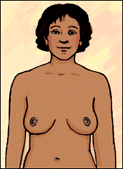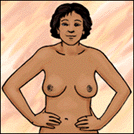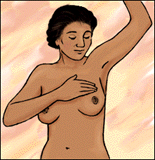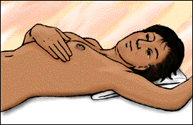
|

|

Ductal cancer in situ, if identified and treated early, can usually be completely eliminated. You may live the rest of your life free from breast cancer. Being a survivor of breast cancer may make you feel a special joy Ð in a sense catching and treating ductal cancer in situ early is the "best case" imaginable. Your future lies ahead, and you have every reason to look forward to a healthy life, with your victory over cancer now behind you.
What helped you defeat your ductal cancer was early detection. Monitoring your health (including your breasts) is part of smart preventative care for yourself. Normal follow-up procedures like breast self-examinations, regular physical examinations, and mammograms are not only important from a medical perspective, but they give you some peace of mind about your health in the future.
It may be normal for your breasts to feel lumpy and uneven. Sometimes, your breasts may be swollen and tender, especially right before your menstrual period.
By doing monthly breast self-examinations, you can learn what's normal for your own breasts at this point in your life. You will be more likely to find an unusual change that might be a warning of cancer. You can ask your health care provider how to perform a breast self-examination.
Read on for step-by-step instructions of how to do a Breast Self Exam.
Continue the steps for breast self exams on your remaining breast.
Stand in front of a mirror that is large enough for you to see your breasts clearly.
Step 2 and 3 check for any change in the shape or contour of your breasts. As you do the steps below, you should feel your chest muscles tighten.
Watching closely, clasp your hands behind your head and press your hands forward.
Next, press your hands firmly on your hips and bend slightly forward toward the mirror as you pull your shoulders and your elbows forward.
Raise one arm. Use your fingers of your other hand to check the breast and the surrounding area Ð firmly, carefully, and thoroughly. Some women like to use lotion or powder to help their fingers glide easily over the skin. Other women do this step in the shower with soapy water. Feel for any unusual lump or mass under the skin.
Feel your breast by pressing your fingers in small, overlapping areas about the size of a dime.
To be sure you cover your whole breast, take your time and follow a definite pattern, like circles or lines.
It's important to repeat the last step while you are lying down. Lie flat on your back, with one arm over your head and a pillow or folded towel under your shoulder. This position flattens the breast and makes it easier to check.
With your arm over your head, check each breast and the area around it very carefully by pressing and moving in a repetitive pattern.
If you notice a lump or discharge at any time, contact your health care provider.
Some breast cancers may not be detected by mammography, especially in pre-menopausal women. Therefore, it also is necessary to have regular breast examinations in addition to regular mammograms.
If you've had a lumpectomy, mammograms may be recommended to the treated breast at 6 month intervals for a year or two. Thereafter, mammograms will be recommended every year. Routine mammography should continue at regular intervals for your untreated breast.
If you have breast implants you may or may not need mammography, depending upon whether or not you still have breast tissue left. If you have had breast reconstruction using your own tissue following a mastectomy, mammograms in your reconstructed breast are not necessary.
Other visits may include some or all of the following procedures:
Your health care provider will tell you when to have your first post-treatment exam. Discuss with your provider the plan for your follow-up care. For example, providers often recommend follow-up visits about every 3 to 6 months for several years.
And being a five-year survivor myself, I guess I feel the one thing that is important when you're diagnosed with cancer is that you seek out a support group and seek out other survivors, because it gives you hope and they understand what you're going through.
Your relationships with people I think become, well they either become much better or much worse. I can't think of any relationships that have become worse. But my relationship with my husband has deepened. We're closer than ever, and this has brought us closer. You have a tendency to tell people more often "I Love You", "I care about you". You have a tendency to do more things for other people. A lot of good things happen.
But I thought about it the other night at the support group. They had a man talk about imagery, and they had us go to Lake Michigan, and I was able to do that quite easily. I thought I probably out to do more meditation. I think it's probably helpful. I found a lot of reasons not to do things that I didn't want to do because of this. I think I used it sometimes, and that's okay, I'm sure. up to Contents of this Page
up to Contents of this Page
Early detection and prompt treatment continue to be the best way to keep your body healthy. Local breast cancer can be treated before it has spread. The earlier breast cancer is found and treated, the better your chances for a complete recovery. To take an active role in early detection of breast cancer, you can:
 up to Contents of this Page
up to Contents of this Page
Women's breasts come in many sizes and shapes. In addition, your breasts change during your life because of age, monthly menstrual cycles, pregnancy, menopause, or the taking of medications. up to Contents of this Page
up to Contents of this Page
If you have had a mastectomy, run your fingers along your incision and feel to make sure it is flat. Check to be sure that no small bumps are present that are new.
 up to Contents of this Page
up to Contents of this Page

 up to Contents of this Page
up to Contents of this Page

 up to Contents of this Page
up to Contents of this Page

 up to Contents of this Page
up to Contents of this Page

 up to Contents of this Page
up to Contents of this Page

 up to Contents of this Page
up to Contents of this Page
Mammograms (x-rays of the breast) can identify many breast cancers before they can be felt. Every woman who has been diagnosed and treated for breast cancer should have a yearly regular mammogram, unless both breasts have been removed. up to Contents of this Page
up to Contents of this Page
Once your treatment is finished, it's important to have regular follow-up exams. During some visits, your health care provider will simply perform a physical exam that includes looking at your breast tissue, incisions, the chest area, underarms, and neck.
 up to Contents of this Page
up to Contents of this Page
![]() Carole's Experience
Carole's Experience
![]() Maggie's Experience
Maggie's Experience
![]() Lucille's Experience
Lucille's Experience
